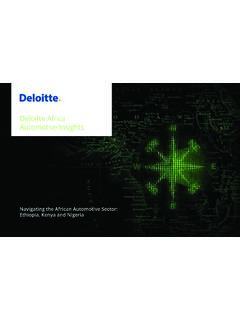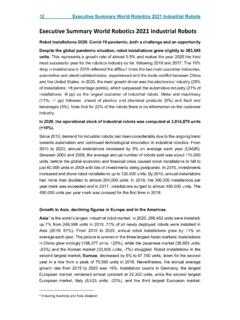Transcription of UDS - ISO 14229 Info - Softing Automotive
1 2016 Softing Automotive Electronics GmbH. Despite all due care and attention, Softing accepts no liability and extends no guarantee for the correctness, completeness or currentness of the additional copies: / one or two setup and start Requests one or two initial Responses are given, followed by 0 to n event-driven Responses depending on the number of occurrences of tracked events. The distance between several events is non-deterministic. The RoE mechanism can be activated in any Session, including the Default-Session It does not need Tester Present messages to stay activeGeneric Event-Driven Communication Flow Example: DTC Status Change Communication FlowPre-defined values for parameter Event Type (6 Bits)$0 Stop Event-Logic$1 Event on change of error memory, e. g. number of errors matching to mask has increased$3 Event on change of measurement s value, which is described by a data identifi er$5 Start Event-Logic$6 Clear Event-LogicUDS Unifi ed Diagnostic Services - ISO 14229 Services without Sub-Function-Byte: $14, $23, $24, $2A, $2E, $2F, $34, $35, $36, $37, $3D, $84 Bit 7: suppressPosRspMsgIndicationBitThis Bit defi nes whether a positive response of the ECU is wanted 0 = FALSE: the ECU shall send a response, that is, no suppression of a positive response shall be done 1 = TRUE: Suppression of the positive response, that is, the ECU must not send a positive responseNegative responses shall be send by the ECU independent of this bitBit 6 to 0: sub-function parameter valueThe Bits 0 to 6 contain the value for a Sub-Function parameter for diagnostic servicesRemark.
2 A service, which uses the suppressPosRspMsgIndicationBit only, shall set the value of the Sub-Function parameter to 0 to support the sending of the bit 7 The Bits 0 to 6 are meaningless thenSuppress Positive ResponseMessage Indication BitBit 7 Sub-Function (Bit 6 to 0)Services with Sub-Function Byte: $10, $11,$19, $27, $28, $2C, $31, $3E, $83, $85, $87 Services with Sub-Function Byte and Storage State Parameter : $86 Bit 7 Bit 6 Sub-Function (Bit 5 to 0) Storage StateThe Sub-Function Byte of UDSI nternational Standard Organization s Open System Interconnect 7 Layer Communication ModelLayerDescriptionStandards for UDSS tandards for OBD 8 Diagnostic ApplicationUserISO 15031-57 Application LayerISO 14229 -1 ISO 15765-3 ISO 15031-56 Presentation LayerNot applicableNot applicable5 Session LayerISO 15765-3 Not applicable4 Transport layerISO 15765-2 Not applicable3 Network LayerISO 15765-2 ISO 15765-42 Data Link LayerISO 11898-1 ISO 15765-41 Physical LayerISO 11898-2* ISO 11898-3 ISO 15765-4*) The bus physics used is to be selected by the user Therefore, several standards for different physical layer for High-Speed- (ISO 11898-2) or Fault-Tolerant-CAN (ISO 11898-3)
3 Can be usedUDS and OBD Positioning in the ISO/OSI Layer ModelUDS Response Handling HexMnemonicDescription10 GRGeneral reject11 SNSS ervice not supported12 SFNSSub-Function not supported13 IMLOIFI ncorrect message length or invalid format14 RTLR esponse too long21 BRRBusy repeat request22 CNCC onditions not correct24 RSER equest sequence error25 NRFSCNo response from sub-net component26 FPEORAF ailure prevents execution of requested action31 ROORR equest out of range33 SADS ecurity access denied35 IKInvalid key36 ENOAE xceeded number of attempts37 RTDNER equired time delay not expired38-4 FRBEDLSDR eserved by Extended Data Link Security Document70 UDNAU pload/Download not accepted71 TDST ransfer data suspended72 GPFG eneral programming failure73 WBSCW rong Block Sequence Counter78 RCRRPR equest correctly received, but response is pending7 ESFNSIASSub-Function not supported in active session7 FSNSIASS ervice not supported in active sessionAll values not described are reserved for future defi nitionCommon Response CodesResponse on Event RoE (Service $86)HexMnemonicDescription81 RPMTHrpm too high82 RPMTLrpm too low83 EIRE ngine is running84 EINRE ngine is not running85 ERTTLE ngine run-time too low86 TEMPTHT emperature too high87 TEMPTLT emperature too low88 VSTHV ehicle speed too high89 VSTLV ehicle speed too low8 ATPTHT hrottle/Pedal too high8 BTPTLT hrottle/Pedal too low8 CTRNINT ransmission range not in neutral8 DTRNIGT ransmission range not in gear8 FBSNCB rake switch(es)
4 Not closed 90 SLNIPS hifter lever not in park91 TCCLT orque converter clutch locked92 VTHV oltage too high93 VTLV oltage too lowAll values not described are reserved for future defi nitionSpecifi c conditions driven Response Codes1) Erase Error Memory ($14 Clear Diagnostic Information) Parameter 1: Service ID = $14 Parameter 2: Diagnostic Trouble Code (DTC) with three byte length2) Sub-Functions for Service $19 Read DTC InformationHexDescription01 Report number of DTC by Status Mask02 Report DTC by Status Mask03 Report DTC Snapshot Identifi cation04 Report DTC Snapshot Record by DTC number05 Report DTC Snapshot Record by Record number06 Report DTC Extended Data Record by DTC number07 Report number of DTC by Severity Mask Record08 Report DTC by Severity Mask Record09 Report Severity Information of DTC0 AReport Supported DTC0 BReport First Test Failed DTC0 CReport First Confi rmed DTC0 DReport Most Recent Test Failed DTC0 EReport Most Recent Confi rmed DTC0 FReport Mirror Memory DTC by Status Mask10 Report Mirror Memory DTC Extended Data Record by DTC number11 Report number of Mirror Memory DTC by Status Mask12 Report number of Emissions Related OBD DTC by Status Mask13 Report Emissions Related OBD DTC by Status Mask14 Report DTC Fault Detection Counter15
5 Report DTC with Permanent StatusError Memory Functions Responses in a CAN data fi eld according to ISO 15765-3 Unacknowledged Segmented Data Transfer (USDT)Type 1 Type 2 Unacknowledged Unsegmented Data Transfer (UUDT)Type 1 Type 2 Responses can be of two different formats/types:Type 1: with Response Service Identifi erType 2: without Response Service Identifi erThe type is respected by the Service $2A Read Data by Periodic Identifi er PCIR esponse ServiceIdentfi erPeriodic Data Identfi erData ( 5 Byte in single frame)PCIP eriodic Data Identfi erData ( 6 Byte in single frame)Response ServiceIdentfi erPeriodic Data Identfi erData ( 6 Byte)Periodic Data Identfi erData ( 7 Byte)Periodic Message Types of UDS Functional UnitSIDA vailable in Default SessionAvailable for RoEHas Sub-FunctionService NameMnemonicDiagnostic and Communication Management$10 Diagnostic Session ControlDSC$11 ECU ResetER$27 Security AccessSA$28 Communication ControlCC$3E Tester PresentTP$83 Access Timing ParameterATP$84 Secured Data TransmissionSDT$85 Control DTC SettingCDTCS$86 Response On EventROE$87 Link ControlLCData Transmission$22 Read Data By Identifi erRDBI$23 Read Memory By AddressRMBA$24 Read Scaling Data By Identifi erRSDBI$2 ARead Data By Periodic Identifi erRDBPI$2C Dynamically Defi ne Data Identifi erDDDI$2E Write Data By Identifi erWDBI$3D Write Memory By AddressWMBAS tored Data Transmission$14 Clear Diagnostic InformationCDTCI$19 Read DTC InformationRDTCII nput Output Control$2F Input Output Control By Identifi erIOCBIR emote Activation of
6 Routine$31 Routine ControlRCUpload Download$34 Request DownloadRD$35 Request Upload RU$36 Transfer Data TD$37 Request Transfer Exit RTES ervice OverviewRequest without Sub-Function or Positive ResponseRequests with Sub-Function ByteUUDT-ResponsesNegative ResponsesService Identfi erData ParameterService Identfi erSub-FunctionByteData ParameterData ParameterNegativeResponseSIDR equestServiceIdentifi erResponseCodeDiagnostic Messages - Structures and TypesSession HandlingPowerOnof the ECUT esterRequest other Session Reset Event-LogicRequest Default Session Reset Event-Logic Enable Security Stop Periodic Transmission Reset Communication State Reset Measurements and SettingsRequest Default Session Complete ResetRequest same or other Session Reset Event-Logic Enable SecurityDefaultSessionNon-DefaultSession TimeoutStandardized values of Parameter Diagnostic Session Type $01 Default Session$02 Programming Session$03 Extended Diagnostic Session$04 Safety System Diagnostic SessionSimple/Polling Diagnostic ServicesThese services consist of one request and one response (max.)
7 For physical addressing, or a group of responses for functional addressingThree Potential Polling Communication Flows Erroneous Communication with Sub-Function Bytewhen using the Sub-Function Byte 1. Positive Response Suppression requested (Bit 7 of Byte 2 is set to 1 , but response is sent by the ECU1. Positive Response2. Negative Response No Suppression requested, response correctly sent by ECU 2. Negative Response3. Response suppressedBit7 Bit6 Bit5 Bit4 Bit3 Bit2 Bit1 Bit00001000 0 Bit7 Bit6 Bit5 Bit4 Bit3 Bit2 Bit1 Bit01000001 1$10 $8310,8350,8310,03 50,03 RequestPositive ResponseRequestNegative ResponseRequest10,03 7F, 10, 12 Specifi cs All services, which have a parameter "Sub-Function", support the "Response-Suppression-Handling" All services to read data do not support this feature A service, which uses the suppressPosRspMsgIndicationBit of the Sub-Function Byte only, must set the other bits of the Sub-Function Byte to 0, to support the transmission of the Bit 7 SuppressPositiveResponseMsgIndicationBit = TRUE Suppression of the positive response All negative responses are send nevertheless For functional requests, some specifi c negative responses are always to be suppressed.)
8 Independent of the value of the Suppress Positive Response Message Indication Bit: Service not supported (NRC $11) Subfunction not supported (NRC $12)"Respond-to"-Services ReadDataByIdentifi er ($22) ReadDTCI nformation ($19) RoutineControl ($31) InputOutputControlByIdentifi er ($2F)Periodic Service Execution (Service $2A)For one Request follows one initial Response. After that, periodically more responses will follow. The sending can be stopped by using a simple diagnostic serviceService parameter "Transmission Mode"The frequency of the data transmission can be confi gured using the the Transmission Mode. The UDS-Standard defi nes abstract values as:Slow = $01 Medium = $02 Fast = $03 Stop sending = $04 The real values in Hertz for each frequency need to be defi ned between OEM and ECU supplier Generic Periodic Communication Flow Type 1 Communication Flow Type 2 Communication Flow A Response Service-ID is sent by the ECU NO Response Service-ID is sent by the ECU1.
9 Setup Periodic Transmission 1. Setup Periodic Transmission for two Measurements ($0C, $0D)2. Getting Periodic Responses 2. Getting periodic Measurements3. Stop Transmission 3. Stop Transmission of Measurement $0C onlyRequestInitial Positive ResponsePositive ResponseRequestPositive ResponsePositive ResponsePositive Response2A, 03, 0C, 0D6A0C, 0A, F02A, 04, 0C0D, 820C, 0A, F00D, 826A2A, 03, 0C, 0D6A6A, 0C, 0A, F02A, 04, 0C6A, 0D, 826A, 0C, 0A, F06A, 0D, 826A6A, 0D, 82 trate 0D, 82 Initial Positive Response tEventStart Event-Logic RequestPositive ResponseEvent Driven ResponseFinal Responset1t3t2t086, 01, 06, 01, 19, 01, 01C6, 01, 00, 06, 01, 19, 01, 0186, 05, 06C6, 05, 00, 0659, 0F, 01, 00, 012nd Step4th Step3rd Step1st StepC6, 01, 01, 06, 01, 19, 01, 01 Setup Event-Logic Request






